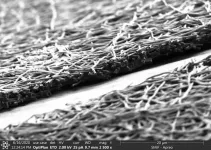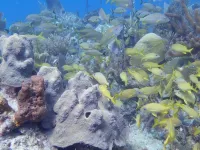(Press-News.org) Alopecia areata (AA) is an autoimmune disease characterized by hair loss, which occurs when T cells of the immune system mistakenly attack hair follicles. To restore control over hyperactive immune cells, investigators from Brigham and Women’s Hospital, a founding member of the Mass General Brigham healthcare system, and MIT developed a cutting-edge approach to deliver T cell regulators directly to sites of hair loss and halt autoimmune activity. Findings, published in Advanced Materials, demonstrated marked and lasting increases in hair regrowth in models of the disease.
Our immune system evolved to safeguard against the overactivation that occurs when it mistakenly attacks our own tissues, as seen in autoimmune conditions. In conditions like AA, the specialized cells known as Regulatory T cells (Tregs) fall short in protecting hair follicles. Current immunosuppressants used in AA target both T cells and Tregs, failing to address the core issue and increasing the risk of disease recurrence once treatment stops. Moreover, systemic immune therapy suppresses the entire immune system, leaving patients vulnerable to infections and malignancies.
The approach tested in this study marks a departure from current therapeutic strategies, which typically utilize immunosuppressants to suppress the immune system. Rather than globally suppressing the immune system, the researchers aimed to locally restore well-controlled immune activity directly at sites of hair loss by increasing levels of Tregs, whose numbers are reduced in AA. This targeted approach was achieved with a microneedle patch, which delivers drugs across the tough outer layer of skin more effectively than topical creams and avoids stimulation of pain receptors, which are located deeper within the skin.
"Our strategy tackles two major challenges in treating autoimmune skin diseases,” said co-corresponding author Natalie Artzi, PhD, of the Brigham’s Engineering in Medicine Division in the Department of Medicine. “Our patches enable local delivery of biologics, which, instead of suppressing the immune system, promote regulatory T cells in the skin. This restores immune balance and resolves the T cell attack on hair follicles, offering a potential long-term solution without compromising the immune system's ability to defend against infections and malignancies.”
"When it comes to autoimmune-mediated skin diseases, where we have direct access to the skin, we must surpass the use of systemic immunosuppressants that shut down the entire immune system,” said co-corresponding author Jamil Azzi, MD, PhD, an immunologist in the Brigham’s Renal Division in the Department of Medicine. “While topical therapy often fails to penetrate the skin's outer layer, our patches improve the local delivery of biologics to the deeper layers of diseased skin and reprogram the immune system to generate tolerance at the site of antigen encounter.”
The researchers, including co-first authors Nour Younis, MD, and Núria Puigmal, PhD, both of Brigham’s Department of Medicine, observed with RNA sequencing that in AA tissues, there were changes in the STAT-5/Interleukin-2 (IL-2) signaling pathway. IL-2, which promotes Treg proliferation, and CCL22, which the researchers had previously shown attracts and expands the presence of Tregs in a specific area, were therefore loaded into the microneedle patch. The patches were applied to murine models of AA 10 times over a course of three weeks, with more than eight weeks of observation. Hair regrowth was observed as early as three weeks after the initiation of treatment. The researchers also tested microneedle patches loaded with baricitinib, a drug approved for severe AA, but found that Treg recruitment was inferior to that associated with the IL-2/CCL22 patch.
The microneedle patch was also found to have good shelf-life stability, improving prospects of its clinical translation. While the therapy is not ready for clinical use, the researchers are pursuing further development and testing. Additionally, they are exploring the possibility of applying their approach to other immune-mediated skin diseases, such as vitiligo and psoriasis.
“Microneedles offer a promising avenue for targeted and localized delivery of therapeutics to the skin,” said Artzi. “Their ability to precisely administer drugs directly to the affected area of the skin enables more effective modulation of the immune response while minimizing systemic side effects. This targeted approach holds great potential for improving treatment outcomes and reducing the burden of autoimmune and immune-mediated diseases on patients' lives.”
Authorship: In addition to Azzi, Artzi, Younis and Puigmal, co-authors from BWH include Andrew Badaoui, Dongliang Zhang, Claudia Morales, Anis Saad, Diane Cruz, Nadim Al Rahy, Andrea Daccache, Triana Huerta, Christa Deban, Ahmad Halawi, John Choi, Pere Dosta, and Christine Lian. Additional authors include Abdallah El Kurdi.
Disclosures: None
Funding: The Department of Medicine at Brigham and Women’s Hospital supported this work through the Ignite Fund Award and the Shark Tank Fund Award.
Paper cited: Younis, N et al. “Microneedle-mediated Delivery of Immunomodulators Restores Immune Privilege in Hair Follicles and Reverses Immune-Mediated Alopecia” Advanced Materials DOI: 10.1002/adma.202312088
END
Researchers develop microneedle patch to reverse hair loss caused by autoimmune disease
Novel treatment approach holds promise for painlessly delivering immune regulators to affected areas of the skin, promoting hair regrowth caused by alopecia areata
2024-06-06
ELSE PRESS RELEASES FROM THIS DATE:
Lakmini Kidder named Senior Vice President of Finance and Chief Revenue Officer
2024-06-06
Lakmini Kidder, MBA, has been appointed to the newly expanded role of Senior Vice President, Finance, and Chief Revenue Officer (CRO) for Vanderbilt University Medical Center (VUMC). Kidder will begin her role on July 22. She joins VUMC from Johns Hopkins Health System in Baltimore, where she served as Vice President of Enterprise Revenue Cycle Management.
In her new capacity, Kidder will assume responsibility for overseeing all aspects of VUMC’s integrated revenue cycle, encompassing hospitals, clinics, the Vanderbilt Medical Group and Vanderbilt Integrated Providers. Additionally, she will oversee revenue management and ...
Discovery highlights ‘critical oversight’ in perceived security of wireless networks
2024-06-06
A research team led by Rice University’s Edward Knightly has uncovered an eavesdropping security vulnerability in high-frequency and high-speed wireless backhaul links, widely employed in critical applications such as 5G wireless cell phone signals and low-latency financial trading on Wall Street.
Contrary to the common belief that these links are inherently secure due to their elevated positioning and highly directive millimeter-wave and sub-terahertz “pencil-beams,” the team exposed a novel method of interception using a ...
Diagnosing damaged infrastructure from space
2024-06-06
As infrastructure ages, it becomes more susceptible to failure, which can cause safety and mobility concerns for drivers and pedestrians, and economic woes for taxpayers. A recent study published in “Transportation Research Record” shows that high-resolution synthetic aperture radar (SAR) satellite data can detect infrastructure issues early on, which can help prevent further damage to roads in the same way that annual checkups can help prevent more complex health issues in humans.
Led by Dr. Anand Puppala and Ph.D. candidate Amit Gajurel, researchers at Texas A&M University are working on a new method of infrastructure monitoring using Synthetic ...
Plenary speakers and key deadlines announced for ISSCR 2025 annual meeting in Hong Kong
2024-06-06
The International Society for Stem Cell Research (ISSCR) convenes world-renown scientists dedicated to stem cell research and regenerative medicine each year at its annual meeting to share the year’s most compelling basic discoveries and clinical breakthroughs in the stem cell field. Abstract submission and registration for ISSCR 2025, taking place 11-14 June 2025, will open on 2 October 2024. Abstracts submitted by 21 January 2025 will be considered for oral presentations and merit and travels awards.
The ISSCR is proud to announce the ...
UTEP pharmacy researchers develop potential treatment for fibrosis
2024-06-06
EL PASO, Texas (June 6, 2024) — Researchers at The University of Texas at El Paso are developing a new therapeutic approach that uses nanoparticles for the treatment of skin and lung fibrosis, conditions that can result in severe damage to the body’s tissues.
Md Nurunnabi, Ph.D., is an associate professor in UTEP’s School of Pharmacy and the lead researcher on two studies published this June in the medical Journal of Controlled Release; one study focuses on skin fibrosis and the other on lung fibrosis.
“We are closer than ever ...
Employers coast to coast join movement to turn bystanders into lifesavers
2024-06-06
DALLAS, June 5, 2024 — Nine out of 10 people who suffer cardiac arrest outside of the hospital die, and cardiopulmonary resuscitation (CPR), especially if performed immediately, can double or triple survival rates.[1] That is why the American Heart Association, celebrating 100 years of lifesaving service, will broaden efforts to drive CPR education at the community level through the Heart Walk® campaign. Heart Walk is the Association’s largest community-based activation engaging more than 220 cities ...
Flavor restrictions affect tobacco buyers differently depending on socioeconomic status, researchers say
2024-06-06
Restricting menthol flavor in cigarettes while making nicotine replacement therapy, such as a skin patch that can help ease withdrawal, more available and affordable has the potential to reduce socioeconomic disparities in tobacco use.
That was one of the findings in a study published in May in Nicotine and Tobacco Research that marks a new use of existing data from the Fralin Biomedical Research Institute at VTC’s Addiction Recovery Research Center. Researchers analyzed data from their Experimental Tobacco ...
Botanists and archaeologists receive National Science Foundation grant to study Mediterranean history
2024-06-06
It’s an unusual collaboration. Botanists and archaeologists don’t often work together, unless they’re studying the way people have used plants through time. But a new four-year grant from the National Science Foundation is shaking things up. It provides more than $1 million to study how Mediterranean plants that people have largely ignored evolved and diversified in one of the most formative periods of human history.
“The Mediterranean is at the crossroads of Europe,” said Nicolas Gauthier, curator ...
Silkworms help grow better organ-like tissues in labs
2024-06-06
DURHAM, N.C. -- Biomedical engineers at Duke University have developed a silk-based, ultrathin membrane that can be used in organ-on-a-chip models to better mimic the natural environment of cells and tissues within the body. When used in a kidney organ-on-a-chip platform, the membrane helped tissues grow to recreate the functionality of both healthy and diseased kidneys.
By allowing the cells to grow closer together, this new membrane helps researchers to better control the growth and function of the key cells and tissues of any organ, enabling them to more accurately model a wide range of diseases and test therapeutics.
The research appears June 4 in the journal Science Advances.
Often ...
Scientists ‘read’ the messages in chemical clues left by coral reef inhabitants
2024-06-06
What species live in this coral reef, and are they healthy? Chemical clues emitted by marine organisms might hold that information. But in underwater environments, invisible compounds create a complex “soup” that is hard for scientists to decipher. Now, researchers in ACS’ Journal of Proteome Research have demonstrated a way to extract and identify these indicator compounds in seawater. They found metabolites previously undetected on reefs, including three that may represent different reef organisms.
Plants and animals living in coral reefs release various substances, from complex macromolecules to individual amino acids, into the surrounding water. To determine ...
LAST 30 PRESS RELEASES:
Making lighter work of calculating fluid and heat flow
Normalizing blood sugar can halve heart attack risk
Lowering blood sugar cuts heart attack risk in people with prediabetes
Study links genetic variants to risk of blinding eye disease in premature infants
Non-opioid ‘pain sponge’ therapy halts cartilage degeneration and relieves chronic pain
AI can pick up cultural values by mimicking how kids learn
China’s ecological redlines offer fast track to 30 x 30 global conservation goal
Invisible indoor threats: emerging household contaminants and their growing risks to human health
Adding antibody treatment to chemo boosts outcomes for children with rare cancer
Germline pathogenic variants among women without a history of breast cancer
Tanning beds triple melanoma risk, potentially causing broad DNA damage
Unique bond identified as key to viral infection speed
Indoor tanning makes youthful skin much older on a genetic level
Mouse model sheds new light on the causes and potential solutions to human GI problems linked to muscular dystrophy
The Journal of Nuclear Medicine ahead-of-print tip sheet: December 12, 2025
Smarter tools for peering into the microscopic world
Applications open for funding to conduct research in the Kinsey Institute archives
Global measure underestimates the severity of food insecurity
Child survivors of critical illness are missing out on timely follow up care
Risk-based vs annual breast cancer screening / the WISDOM randomized clinical trial
University of Toronto launches Electric Vehicle Innovation Ontario to accelerate advanced EV technologies and build Canada’s innovation advantage
Early relapse predicts poor outcomes in aggressive blood cancer
American College of Lifestyle Medicine applauds two CMS models aligned with lifestyle medicine practice and reimbursement
Clinical trial finds cannabis use not a barrier to quitting nicotine vaping
Supplemental nutrition assistance program policies and food insecurity
Switching immune cells to “night mode” could limit damage after a heart attack, study suggests
URI-based Global RIghts Project report spotlights continued troubling trends in worldwide inhumane treatment
Neutrophils are less aggressive at night, explaining why nighttime heart attacks cause less damage than daytime events
Menopausal hormone therapy may not pose breast cancer risk for women with BRCA mutations
Mobile health tool may improve quality of life for adolescent and young adult breast cancer survivors
[Press-News.org] Researchers develop microneedle patch to reverse hair loss caused by autoimmune diseaseNovel treatment approach holds promise for painlessly delivering immune regulators to affected areas of the skin, promoting hair regrowth caused by alopecia areata








